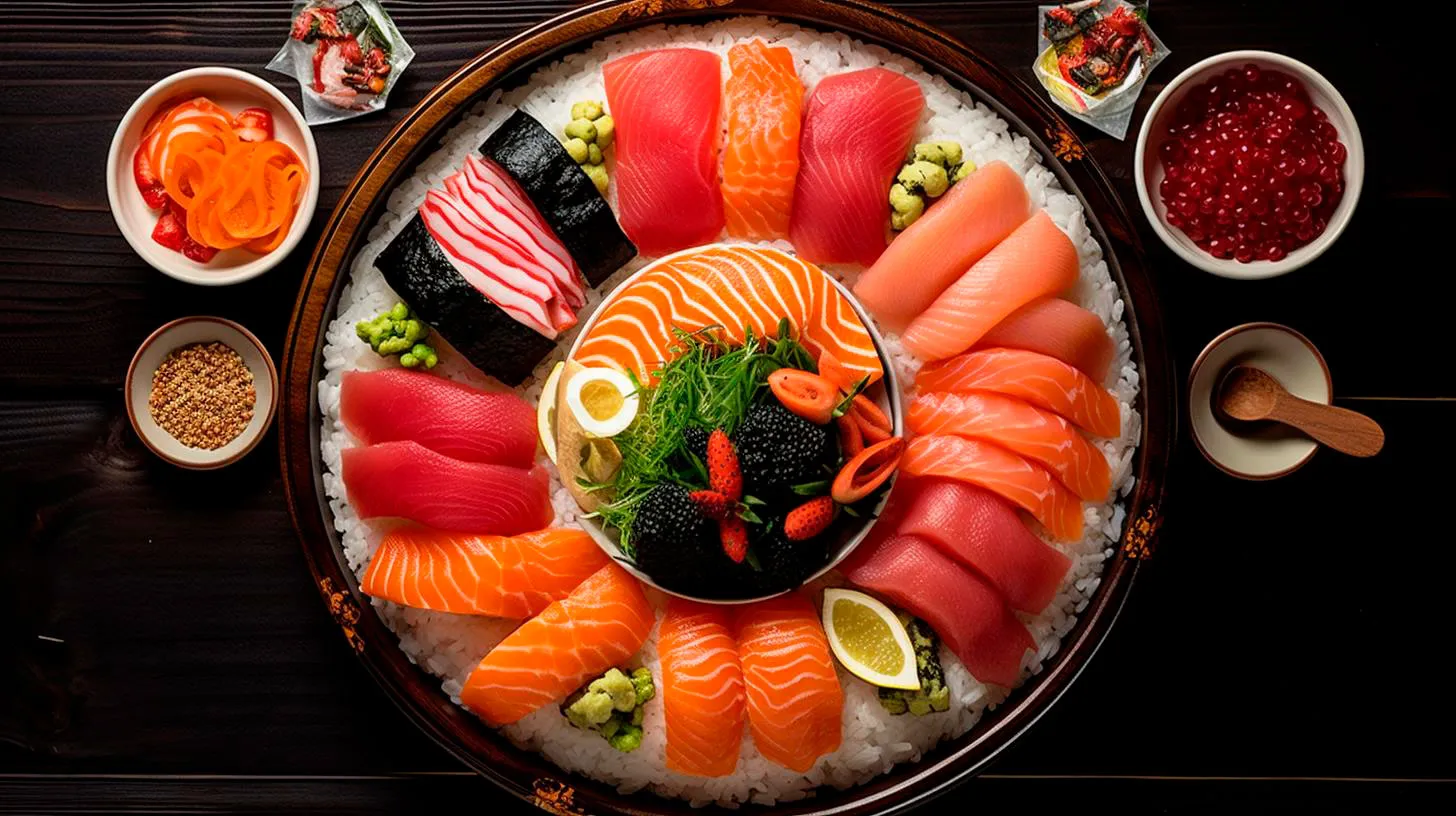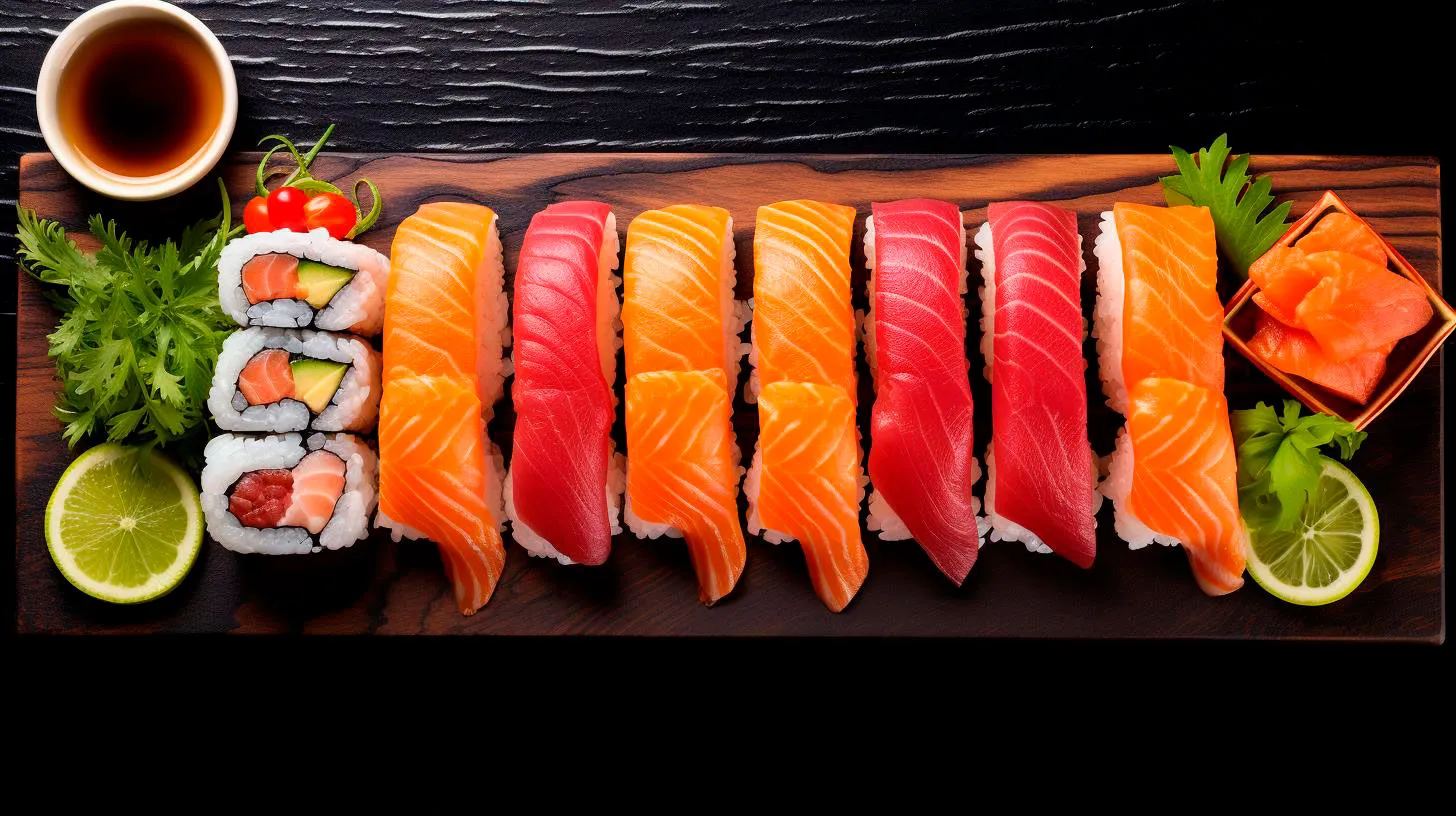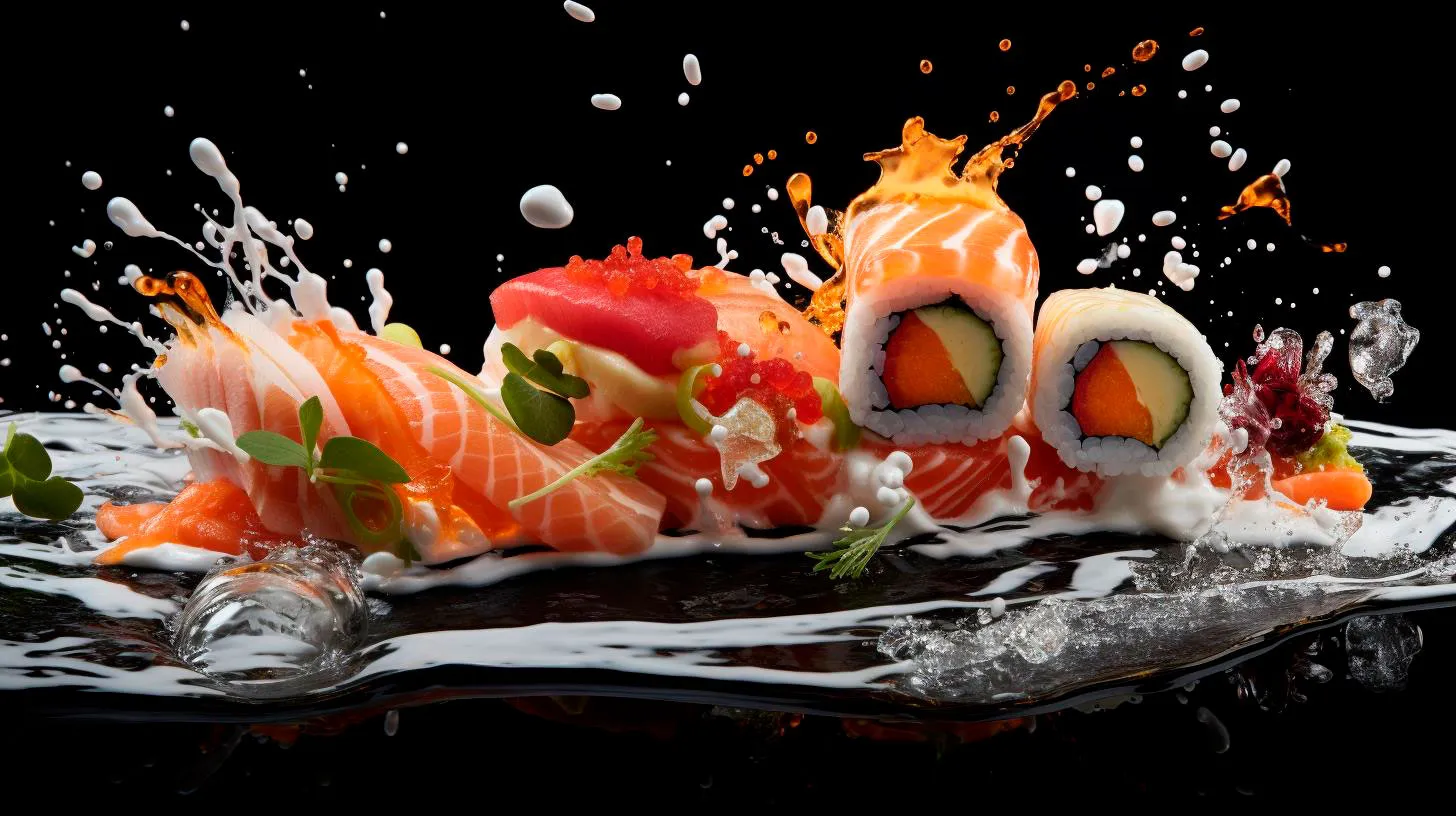Unveiling the Hidden Risks of Sushi and Allergies
Sushi, often regarded as a healthy choice due to its fresh ingredients and high nutritional value, can contain hidden allergens that could lead to severe allergic reactions. In this article, we will explore the hidden risks of sushi and allergies, shedding light on the importance of understanding ingredient composition, cross-contamination, and making informed choices for a safe dining experience.
Understanding Allergies and Sushi
Allergies are immune responses triggered by specific proteins in certain food items. Among the most common food allergens are fish and shellfish, both of which are featured prominently in various sushi preparations. For individuals with allergies, consuming sushi can become a potentially life-threatening experience unless proper precautions are taken. It’s crucial to identify and comprehend the risks associated with sushi consumption to ensure a safe dining experience for everyone.
Risks and Hidden Ingredients
1. Cross-contamination: Sushi bars and restaurants are bustling environments where different ingredients and utensils come into contact with one another. Cross-contamination can occur when surfaces, knives, cutting boards, and utensils used to prepare sushi are not properly cleaned and sanitized. This can lead to traces of allergens being transferred to supposedly safe dishes.
2. Soy sauce: The common condiment regularly used with sushi, soy sauce can contain wheat. It’s important to note that wheat allergies are prevalent and can lead to serious reactions. Opting for gluten-free soy sauce or tamari is a safer choice for those with wheat allergies.
3. Wasabi and condiments: Wasabi, a spicy Japanese horseradish, is another ingredient that may have hidden allergens, such as mustard, which can cause severe allergic reactions. Additionally, some condiments, like spicy mayo or eel sauce, can contain allergenic ingredients like eggs, soy, or seafood extracts. Being aware of the specific ingredients used in sushi condiments is crucial for individuals with allergies.
4. Sneaky fillings: Sushi rolls often contain unexpected fillings that might not be mentioned on the menu. These can include imitation crab meat, which contains fish extracts that could trigger allergies. Other fillings may include sesame seeds, which can cause reactions in individuals with seed allergies. Always ask about the specific ingredients or consult with the sushi chef to avoid hidden allergens.
Guidelines for Safe Sushi Consumption
1. Communication is key: When dining out, it’s vital to inform your server or sushi chef about any allergies you may have. They can provide recommendations, suggest suitable menu options, ensure proper handling of your order, and minimize the risk of cross-contamination.
2. Research and choose trusted establishments: Before dining at a sushi restaurant, take a moment to research their reputation. Look for reviews, ratings, and certifications that demonstrate their commitment to food safety and meeting customer dietary requirements.
3. Double-check condiments and sauces: It’s advisable to inquire about the ingredients present in soy sauce, wasabi, and other condiments on the table. By doing so, you can make informed choices and avoid potential allergens hidden in these accompaniments.
4. Be cautious with buffet-style sushi: Buffet-style sushi can present risks of cross-contamination due to the shared utensils and exposure of raw fish to other foods. If you have allergies, it may be safer to opt for freshly made-to-order sushi or order from a reputable a-la-carte menu.
Key Takeaways
The allure of sushi lies not only in its exquisite taste but also in its cultural significance. However, for those with allergies, consuming sushi can pose unintended dangers. Here are the key takeaways to remember:
- Be aware of hidden allergens and cross-contamination risks associated with sushi.
- Stay informed about the potential allergens present in condiments like soy sauce, wasabi, and various sauces.
- Ensure proper communication with servers and sushi chefs regarding your allergies to receive safe recommendations.
- Choose reputable sushi establishments that prioritize food safety and cater to dietary requirements.
- Ask questions and double-check ingredients to avoid unexpected allergic reactions.
By understanding and mitigating the risks associated with sushi and allergies, individuals with dietary restrictions can still enjoy this beloved cuisine without compromising their health and well-being.
Sushi Allergies: An Emerging Concern
In this article, we will explore the emerging concern of sushi allergies and provide insights into its causes, symptoms, and prevention methods.
The Rise of Sushi Allergies
Over the past decade, the number of reported sushi allergies has been on the rise. It is estimated that approximately 1-3% of the population is affected by some form of seafood allergy, with shellfish allergies being the most prevalent. However, allergies specifically related to sushi and raw fish are starting to gain attention.
One factor contributing to the rise of sushi allergies is the increased consumption of raw fish. Traditional sushi, known as nigiri, consists of raw slices of fish placed on bite-sized mounds of vinegared rice. The popularity of sushi bars and all-you-can-eat sushi buffets has made raw fish more accessible, leading to higher exposure rates and a subsequent increase in allergic reactions.
Causes and Symptoms of Sushi Allergies
Allergic reactions to sushi can occur due to various reasons. For some individuals, the primary cause is an allergic reaction to specific proteins found in raw fish, such as tropomyosin, a muscle protein. Other individuals may have a shellfish allergy, which can also lead to allergic reactions when consuming sushi.
The symptoms of sushi allergies can range from mild to severe, including:
- Itchy skin
- Hives
- Swelling of the lips, tongue, or throat
- Nausea and vomiting
- Abdominal pain
- Diarrhea
- Difficulty breathing
- Anaphylaxis (a severe and potentially life-threatening reaction)
Preventing Sushi Allergic Reactions
If you suspect you have a sushi allergy or have experienced any symptoms after consuming sushi, it is crucial to seek medical attention and get tested by an allergist. They can help determine the specific allergens triggering your reactions and provide guidance on how to manage and prevent future allergies.
To minimize the risk of allergic reactions, here are some key takeaways:
- Inform your sushi chef about your allergies to ensure they can accommodate your needs.
- Avoid cross-contamination by using separate utensils and cutting boards for raw and cooked foods.
- Read food labels carefully and ask about ingredients when dining out.
- If you have a severe allergy, consider carrying an epinephrine auto-injector (EpiPen) for emergency situations.
The Future of Sushi Allergies
With the increasing popularity of sushi globally, it is essential for sushi chefs, restaurants, and customers to be aware of sushi allergies. As the number of reported cases rises, it is expected that there will be a greater focus on ingredient transparency, allergen labeling, and the development of alternative sushi options for individuals with allergies.
Restaurants that provide detailed information about allergens and offer allergen-safe sushi options may attract a larger customer base, inclusive of those with food allergies. Additionally, continued research and education on sushi allergies will help raise awareness among the general public and healthcare providers, ultimately leading to better management and prevention of these allergies.
Key Takeaways
To recap, here are the key takeaways regarding sushi allergies:
- Sushi allergies are an emerging concern, with the number of reported cases on the rise.
- Causes of sushi allergies can include allergic reactions to specific proteins in raw fish or pre-existing shellfish allergies.
- Symptoms range from mild skin reactions to severe anaphylaxis, requiring immediate medical attention.
- Prevention involves communication with sushi chefs, careful food handling, and being knowledgeable about food labels.
- The future may see improved ingredient transparency, allergen labeling, and the introduction of allergen-safe sushi options.
As sushi continues to be a popular choice for food enthusiasts worldwide, it is crucial to be aware of the potential risks and symptoms associated with sushi allergies. By staying informed, taking precautions, and seeking professional advice, individuals with sushi allergies can still enjoy this culinary delight while keeping their health a top priority.
Stay Aware Stay Safe: Understanding Sushi-Related Allergy Risks
The Rise of Sushi Allergies
Allergies to sushi ingredients have been on the rise, and it’s essential to recognize the potential risks. Some studies indicate that up to 3% of the world’s population may have an allergy to fish or shellfish, two of the primary ingredients found in sushi. In fact, seafood allergies are one of the most common food allergies globally.
When it comes to sushi allergies, it’s not just limited to fish and shellfish. Some people may also have allergic reactions to other components such as seaweed, soy sauce, and even wasabi. It’s crucial to understand these risks to avoid potential discomfort or serious health consequences.
Understanding Sushi Allergens
Now, let’s dive deeper into some of the common allergens associated with sushi:
- Fish and Shellfish: These are the primary ingredients in most sushi rolls. Allergic reactions can range from mild to severe, with symptoms such as hives, swelling, difficulty breathing, and in extreme cases, anaphylaxis.
- Seaweed: While less common, some individuals may develop an allergic reaction to seaweed, leading to symptoms like skin rashes, itching, or digestive issues.
- Soy Sauce: Soy sauce is a staple condiment in sushi, but it contains soybeans. Soy allergies are prevalent, and symptoms may include hives, itching, stomach pain, or even anaphylaxis.
- Wasabi: Despite its small serving size, wasabi can trigger allergic reactions in some individuals, causing symptoms like swelling, throat tightness, or difficulty breathing.
Prevention and Risk Mitigation
While sushi allergies can pose a challenge, there are steps you can take to prevent and mitigate potential risks:
- Read the Menu Carefully: When dining at a sushi restaurant, thoroughly review the menu to identify potential allergens in each dish. Ask your server about any ingredients you’re uncertain about.
- Communicate with the Chef: If you have allergies, don’t hesitate to inform the sushi chef about your dietary restrictions. They can guide you towards safe options or make necessary adjustments to recipes.
- Consider Allergy-Friendly Alternatives: If you have severe allergies and want to enjoy sushi without risking cross-contamination, consider allergy-friendly alternatives such as vegetarian rolls or sushi made with cooked fish.
- Carry Medications: If you know you’re prone to allergic reactions, make sure to carry appropriate medications, such as antihistamines or an epinephrine auto-injector, to counteract any potential severe allergic reactions.
- Self-Test: For those unsure about their allergies, consulting with a qualified allergist to perform an allergy test can provide invaluable insights into any potential risks.
Key Takeaways
Sushi is undoubtedly a delicious and exciting culinary experience, but understanding the potential allergy risks is crucial for a safe dining experience. To summarize, remember the following key takeaways:
- Allergies to sushi ingredients, such as fish, shellfish, seaweed, soy sauce, and wasabi, are on the rise.
- Familiarize yourself with the common sushi allergens and know the symptoms in case of an allergic reaction.
- Read menus carefully, communicate your allergies to the chef, and consider allergy-friendly alternatives if necessary.
- Carry necessary medications in case of severe allergic reactions.
- Consult with an allergist for a comprehensive allergy test if you’re unsure about any potential allergies.
By staying informed, you can still indulge in the joy and flavors of sushi while keeping your health and safety in mind. Remember, it’s always better to be aware and take necessary precautions to stay safe and enjoy your delicious sushi experience!
Is Your Favorite Sushi Safe? Identifying Risk Factors
In this article, we will explore the risk factors associated with sushi preparation and consumption and provide you with valuable insights to ensure a safe dining experience.
The Risks of Consuming Sushi
Sushi, a traditional Japanese dish, typically consists of raw or cooked fish, rice, seaweed, and a variety of fillings. While sushi can be a delicious and healthy choice, there are certain risks associated with its consumption:
- Bacterial Contamination: Raw fish used in sushi can carry harmful bacteria, such as Salmonella and Listeria, which can cause foodborne illnesses.
- Parasitic Infections: Some species of fish used in sushi can contain parasites, such as Anisakis, which can lead to gastrointestinal problems if not properly prepared.
- Mercury Levels: Certain predatory fish, like tuna and swordfish, may contain high levels of mercury, which can be harmful, especially for pregnant women and young children.
Identifying Risk Factors
Although the risks associated with consuming sushi exist, they can be mitigated by identifying and addressing certain risk factors. By being vigilant and informed, you can ensure the safety of your favorite sushi. Here are some key factors to consider:
1. Sourcing and Freshness of Ingredients
One of the primary risk factors in sushi preparation is the quality and freshness of the ingredients used. Look for sushi restaurants that prioritize sourcing their fish from reputable suppliers. Fresh fish should have a mild aroma, firm texture, and vibrant color. Fish that smells overly fishy or has an off-putting texture should be avoided.
Key Takeaway: Choosing sushi restaurants that emphasize ingredient quality and freshness reduces the risk of foodborne illnesses.
2. Proper Handling and Storage
Proper handling and storage of fish play a crucial role in preventing bacterial contamination and parasitic infections. Fish should be stored at temperatures below 40°F (4°C) to prevent bacterial growth. Additionally, sushi chefs must follow strict hygiene practices, including frequent handwashing, sanitizing utensils, and using separate cutting boards for raw and cooked ingredients.
Key Takeaway: Ensuring that your sushi is prepared by well-trained chefs who adhere to proper food handling practices minimizes the risk of bacterial contamination.
3. Sushi Rice Safety
While fish is often the primary concern, the sushi rice itself can also pose risks if not handled properly. It is essential to use seasoned rice vinegar in sushi preparation to maintain a low pH, reducing the risk of bacterial growth. Additionally, rice should be kept at the proper temperature, ideally below 41°F (5°C), to inhibit the growth of harmful bacteria.
Key Takeaway: Well-prepared sushi rice, with correct seasoning and storage conditions, is crucial for minimizing the risk of foodborne illnesses.
4. Making Wise Choices
Lastly, making wise choices when selecting sushi can significantly contribute to a safe dining experience. Avoid consuming sushi containing potentially high mercury fish, especially if you are pregnant or have young children. Instead, opt for sushi made with low mercury fish like salmon and shrimp, which are generally safer options.
Key Takeaway: Choosing low mercury fish options reduces the risk of mercury-related health issues.
Conclusion
While sushi can be a delightful culinary experience, it is essential to be aware of the associated risks and take necessary precautions. By considering the sourcing and freshness of ingredients, proper handling and storage practices, rice safety, and making wise choices, you can enjoy your favorite sushi with peace of mind. Remember, an informed sushi lover is a safe sushi lover!



